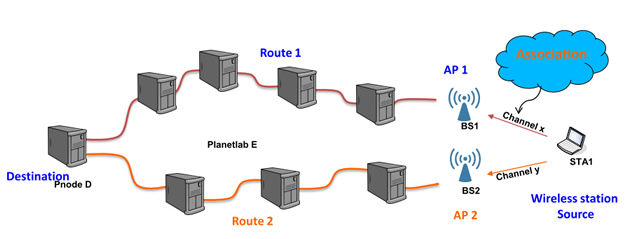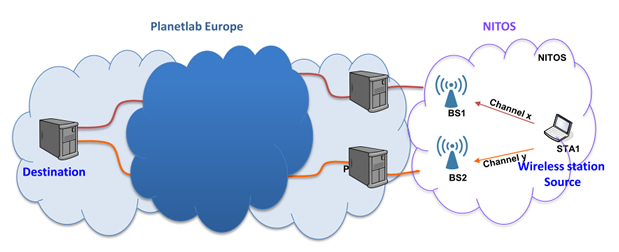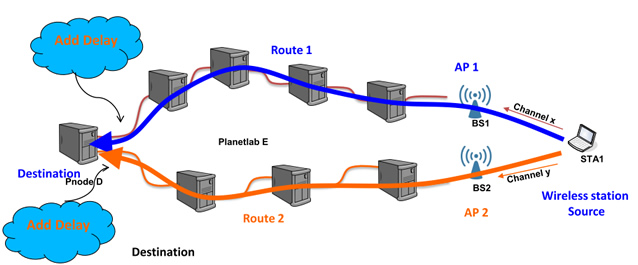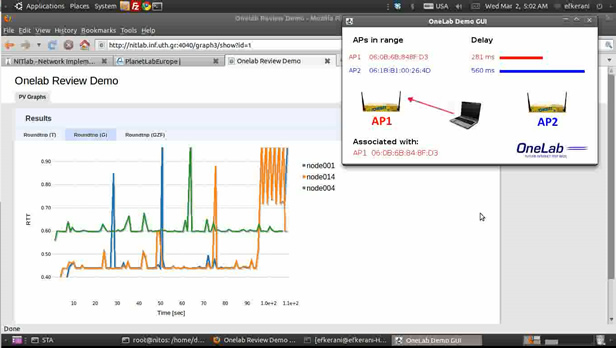PlanetLab-NITOS Federation
1. The Scenario
The experiment highlights the importance of association mechanisms in the general context of a network involving wired and wireless (Wi-Fi) components. The scenario is that of figure 1. A wireless station operating in an environment with two available access-points is sending traffic to a remote destination through the Internet. In current 802.11 WLANs, the station selects the AP to associate with only taking into account the RSSI values from the APs. This is clearly suboptimal even in an exclusively wireless context and much research work has focused on proposing new association metrics. The goal of this experiment is to shed light on an important parameter, often neglected in this context, the fact that the perceived QoS of a station depends on end-to-end performance metrics, rather than AP-specific metrics. In particular, one specific metric is taken into account, the end-to-end delay. However it is clear that extensions to more complex end-to-end metrics are relatively straightforward.

Figure 1: The scenario of our user association experiment
2. Resources involved
A synergy between two different testbeds is established for the purposes of the experiment, namely between the NITOS wireless testbed, located at the premises of the University of Thessaly, and the large-scale distributed Planetlab Europe wired testbed. The University of Thessaly has two Planetlab nodes deployed at their facilities. These nodes are connected to two wireless nodes of NITOS, configured to operate as access-points. A third wireless NITOS node, in range with the former two, is used as the station sending the traffic. This traffic is destined to a remote Planetlab node, located at the INRIA facilities in Paris, France. The synergy between the two testbeds is depicted in Figure 2.

Figure 2: The synergy of NITOS and PLE during the experiment
3. Experiment Description
The three wireless nodes at NITOS are running modified versions of the MadWifi open-source driver. At the APs the drivers read a delay value from a specific proc-file. This value is obtained for each node through periodic pings to the destination node at INRIA taking place at the application level at regular time intervals. Each AP advertises this value through beacons, so that wireless stations in their neighborhood can take this parameter into account for their association decision. At the station side, the driver has been modified, so that the station associates to the AP with the lowest delay value, rather than to the AP with the highest RSSI. Again, it is clear that alternative policies using combined metrics of RSSI, delay and other parameters are straightforward to implement.

Figure 3: The actual scenario - Delay emulation through Dummynet
In order to control the delay of the different routes to the destination, a network emulator is being used on the destination side, Dummynet in particular. We configure Dummynet to apply different delays to the streams arriving from the two APs at NITOS and change this configuration periodically on the fly, as the experiment is running. The APs running the periodic ping applications sense these changes and update the relative proc-files accordingly.
Download the experiment description in OMF:
4. Related paper
You can also download the relevant paper accepted in Tridentom 2012:
Keranidis_Federation_TridentCom_2012_paper.pdf
5. Demonstration through OMF

Figure 4: Screenshot from our Demonstration Video
The whole experiment is orchestrated through the OMF testbed control and management framework. NITOS has adopted OMF as its software framework and Planetlab nodes can incorporate OMF software upon request.


